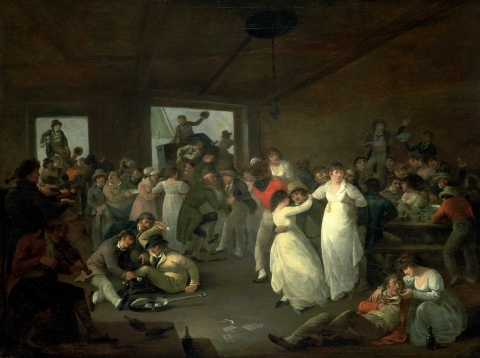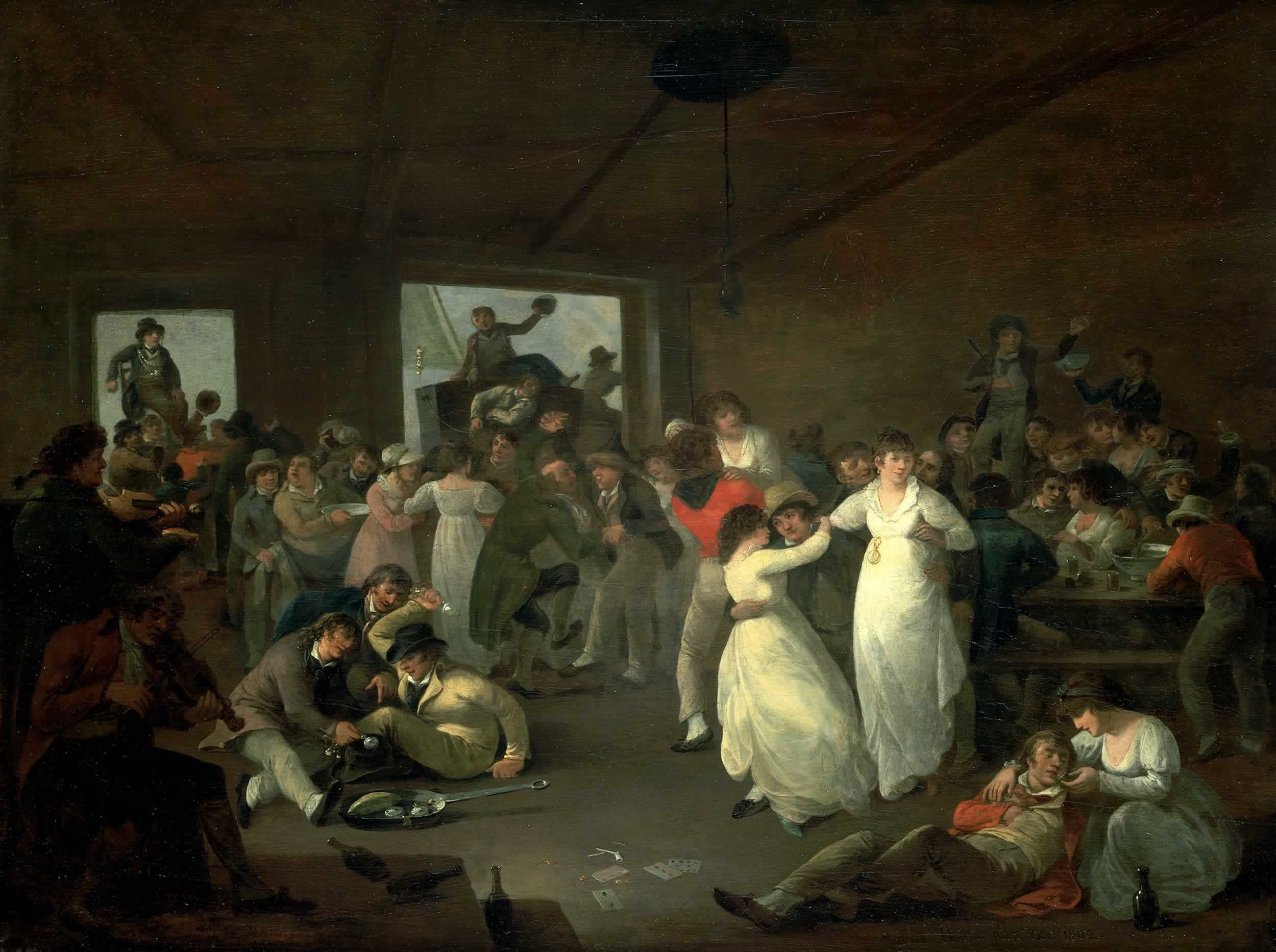The Two Madame’s of Portsmouth!
Getting Your Whore on – The Two Madame’s of Portsmouth
A walk down any Portsmouth street, whether it be in this century or one past, will show you a city that is full of arts, culture and architecture. Grand Federal, Georgian and neo-classical designed houses now sit alongside barbershops, restaurants and the remnants of the 1970’s when architecture was nothing more than stacking a few clumsy slabs of granite together. Though much can be gained from looking at these building they do not tell the whole story of the city and they do little to remind a modern tourist that these streets were once rough and bawdy and full of women willing to do anything for money. And by anything I mean anything.
You can turn on any television today and see women with wildly colored hair that looks more at home on a rainbow than on someone’s head. There was nothing subtle about the working girl and If you want to discover some of the intrigue that created this city you must know they were no accepted in society the society was forced to acknowledge them as a part of the fabric of the town; a piece of soiled fabric. If you want to know how Portsmouth really grew up you would have to go beyond the buildings and open some doors.
Portsmouth has always been a city that has relied on its proximity to the water. As one of the major ports on the East Coast of both the 17th and 18th century shipbuilding, especially during wartime, was the fuel that kept the Seacoasts engine running. To that end, the countries first navy started to take shape with the establishment of the Portsmouth Naval Shipyard in 1800 during the presidency of John Adams. The yard is the oldest continuously operating shipyard in the United States and still employs thousands of men and women today. It has such a long history that the British warship the Falkland was built at the yard before it became the property of the United States. This all explains what the shipyard workers did by day – our concern here is what and with whom they did by night.
For centuries men have worn two faces. By day they are the respectable father and husband who provides for his family and contributes, in varying degrees, to the health of the community. By night however Man becomes something else entirely. It has often been said that a man is governed by two heads: one on his shoulders and one in his drawers. It is the head he keeps near his pockets that make most of the decisions after dusk and unfortunately that head is pretty close to his wallet. The men of the military are no different.
The men at the shipyard liked to work hard and they liked to play hard which most certainly gave rise to the Red Light District located directly across the Piscataqua River from them on Water Street. From the late 1890s to right before the start of World War 1, brothels thrived near the docks. In its heyday, 12 houses of ill repute serviced more than 1,500 men per night and though revolving doors had yet to be invented you can imagine that the comings and goings of these gentlemen on any given night gave new meaning to the phrase “foot traffic”.
Not to belabor the math but let’s take a moment to figure this out. If there were roughly 12 whorehouses and each whorehouse, let’s say had 10 whores (just to make the math easier) and at the height of business there were 1,500 men per night than that would mean that each girl would service 12.5 men per night. AT the average rate (in the 1900s anyway) of $2 a poke with the girl keeping half that means a whore could make almost $13 a night, not including tips! (The again not many customers were Jewish) I guess a lot of that money would have been used for trips to the chiropractor and cases of talcum powder! After all, a girl does have to be ready to party.
Liberty Parties were what the sailors called their nightly forays into the world of prostitution and since the Memorial Bridge would not be built until 1923 the sailors had to make other arrangements to get across the river to satisfy their lust. Ingenuity and entrepreneurship were the order of the day and thanks to Charles Walker, who owned the nearby coal docks, the transported sailors, for a small fee of course, ventured out from the service of their country into the service of another master. Unfortunately, any sailor found in a bordello in uniform would be discharged from his post, and because there was enough discharge all ready occurring in the beds on Water Street, another entrepreneur was needed. Faster than a sailors pants would hit the floor a shop to rent suits of clothing was established. Luckily for the business owner the sailors were charged for the clothes and not for the amount of time they spent in them.
Of course a man spending his money on a prostitute was nothing new but it was never love for sale as it is love for rent, or lease with no option to buy. The first prostitutes date as far back as 2400 BC and that does not stand for before chlamydia. Long before the whores washed up on the new shores of America it had spread through the ancient world starting in Asia then Rome and even Greece where they knew how to separate the men from the boys – with a crowbar.
Throughout history there have been different attempts to harness this form of not-so-free trade. In 1751 the Chastity Commission of Vienna was instituted and in 1864 the Contagious Disease Act of Britain was enacted as a way to battle the venereal disease that was the scourge of the city. In 1897 New Orleans enacted the Lorette Ordinance, which prohibited prostitution in the first floor only leading to the phrase “Why don’t you come up – and see me sometime?”
The oldest continually running whorehouse in America however was not located in Portsmouth or even the East Coast. The Dumas Brothel, which served its clientele from 1890 to 1982, in Uptown Butte, Montana holds that record. It is currently used as a museum and is listed as a National Historic Landmark. Finally a reason to go to Montana.
It was not until 1911 that the Supreme Court decision of Hoke v. United States that stated that prostitution was the province of the states and not the federal government, which is why all the whores now live in Nevada.
Back in Portsmouth, in 1912, Constance Perry was convicted of white slavery after luring a Dover girl to Portsmouth to work in a brothel. This was perhaps the beginning of the end and but not the end of coming up with ingenious ways to get girls to sell their bodies for money. When a show failed at the Music Hall all of the dance hall girls were forced into prostitution in order to pay for their railway fares back home
Of course all of these laws and ordinances were pretty much started to stop people from doing what they wanted to do in the first place – have sex. Apparently in America some things were still not for sale even when the owner was open and willing for business. Not just ordinary sex but every type of sex and if variety was the spice of life then there was a lot of spice flowing in the Granite State.
The Portsmouth houses offered a variety or tastes and services to a variety of customers and call them what you like whether it be a bordello, brothel, cathouse, bawdyhouse, whorehouse, bagnio or house of ill repute, they all sold sex for money and most of them, though not all of them, were run by strong women. Sailors could chose from the Commercial House, The Clifton House, The Elm House, “”Big” Etta DeForrest House, The Home, the American House, The Glouster House and of course the “saloon” run by Alta Roberts. Though the Red Light District was where the majority of men would go to get their rocks off there were houses of ill repute located throughout the city.
The Red Light District, or the place in a city where sex is sold, is not so much a place where there is no order of law but where there is a perceived failure of the law. As you can imagine the upper crust of society including politicians, policemen and clergymen often visited these establishments though would deny ever having stepped forth into such a place on any given Sunday morning. Surely these people had the law and not instant gratification utmost in their minds. In those days the paparazzi was not as prevalent, hell photography was a new art, so most of the elite slipped in and out without notice.
Famed citizen and tycoon Frank Jones, who was a friend of Theodore Roosevelt’s and who housed the delegates from both Russia and Japan during the discussions which lead to the signing of the Peace Treaty of 1905, owned the Glouster House. Though he hobnobbed with the highest of society he also had lower more primal tastes as well. He was not alone, James Kehoe, a Portsmouth police officer who spent his days enforcing the law, spent his nights helping citizens break the law as owner of the Clifton House!
It was a large cookie jar and people could not stop themselves from sticking their hand through into the hole! Frank Jones, though married, used the girls to entertain his many business associates who stayed at his Rockingham Hotel. It is said that he had paintings done on the ceilings of some of the rooms so the girls would have something to look at while “entertaining”. Business was booming and there were plenty who were looking to get more bang for their….well, you know. There were many who thrived during this heyday but no one flaunted their success more than Mary Baker.
Mary Amazeen Baker was a tough-as-nails broad who would pull out all the stops to make The Glouster House the preeminent brothel in the city. She tried (though not very hard) to present herself as a respectable businesswoman by promoting her establishment as a saloon and ice cream parlor to some, there could be no mistake when you met he that licking ice cream was not the first act on her mind, though it did involve some licking.
She was nearly impossible to miss and even in the shadowy world of prostitution she glowed like a neon sign. She hennaed her hair to a bright red and flipped it up into a beehive that could not be missed for blocks. She wore outlandish dresses she thought elegant and adorned herself with overly wrought jewelry that she wore with her signature velvet choker and a fur muff. It was her teeth however, that got her the most attention. As if it were an appropriate advertisement to the prosperity of her business Mary Baker had two diamonds embedded into her two front teeth beating modern day rappers and their grills by more than 100 years.
Of course it was her promotional skills that would have rivaled Florence Ziegfeld had Ziegfeld promoted hookers who did a lot more than just stand there and look beautiful. Baker would routinely meet her new girls at the train station and parade them throughout the center of town as if they were the weekend special at the local deli. Much like a dinner special or a soup that had been served one day too long once all the public all their taste the girls would be switched out for something new and fresh and the whole circus would start again.
Once at the Glouster House visitors would step into a lush grand ballroom filled with fanciful adornments, red velvet curtains and paintings of naked women that would allow their imaginations (and wallets) to run wild. In the center of the room was a large chandelier, which appeared even larger than life thanks to the mirrors on the ceiling. Many people think of mirrors on the ceiling as an invention of the seventies when garish rooms made strange bedfellows with disco and cocaine but it was at the turn-of the-century when people started using their reflection from purposes other than hygiene.
Baker wanted her clients to escape into a world of fantasy and she created a world where men could be treated like naughty little boys. These adornments and fantasies had value and Baker sold them by the bed full to men who longed for escape after a hard and grueling day on the docks. There was very little waiting at the Glouster House to satisfy these urges as little cubbies cut into the walls were where the girls were stashed allowing men to “relieve” themselves between courses of their evening meal.
Opulence was the order of the day at The Glouster House and when Frank Jones died in 1902 Mary Baker was finally allowed to own the establishment that many thought was hers all ready. Down the street less than a city block was a house of a different sort – the house of Alta Roberts. Though Roberts lacked much of Bakers “refinement” she succeeded in ways Baker had never considered for if there was a beating heart on Water Street it belonged to Alta Roberts.
Unlike Baker, bordello owner Roberts House Saloon operator Alta Roberts was almost never seen in public and would rather have been found dead than in one of Baker’s garish costumes. Roberts was a much quieter woman who always wore black, perhaps because as a young woman she lost her child giving birth and was never to have any children. Once she lost her husband her dark attire earned her the nickname “The Black Mystery”. Perhaps because of this longing she took great care not only of her girls but also of many of the dockyard people who had nowhere else to go for a warm place to sleep or for their only hot meal of the day.
After her husband died she needed a way to make a living so she changed the building into a dance hall complete with a band and leapt head first into the world of prostitution. Her care for her girls showed in the interview she would conduct with each gentleman before they were allowed to go upstairs to the service rooms. After all, she wanted to make sure that a gentleman of a proper caliber was with her whores!
Roberts treated each of her girls as if they were the most beautiful girls in the city. She would split the two-dollar fee evenly which not only provided an incentive to other girls to join the fray but also allowed many of the working girls to save and find a better life. Their health was also taken care of thanks to Roberts who made sure every girl saw the doctor regularly and who made their clean bills of health public knowledge. Not a complete wallflower Roberts, perhaps inspired by Baker, Roberts wore gold casings on her teeth.
Though Roberts was a Madam her legacy is more of a humanitarian than a brothel owner. Her compassion for those less fortunate than her was as strong as her desire to survive herself. She was known for her generosity to the poor and homeless and often shielded those from the winters cold in the third floor of her brick building. Despite all of the fires and natural disasters that weather and man have wrought on the area it is Alta Roberts house that still stands today.
The same cannot be said of the “Emporium” located on Four Tree Island or better known as “Leper Island” because of its remoteness. It cost you fifty cents to get on the island and five dollars to get back. The Emporium, decorated with ivory tusks, shrunken heads, Jesse James boots and a stuffed cow where a squeeze of its udders was needed in order to fill your glass, catered to the very bottom of society. It’s remoteness eventually served to be its end, as a fire in 1906 could not be doused because the fire equipment could not make it to the island. Perhaps the fire department did not have the correct change.
Packy Stewart’s brothel boasted 16 ladies which he replaced every two weeks, as if each one had an expiration date stamped somewhere on their bodies. There were those who have said that by a push of a button a version of pornographic paintings could appear or disappear on the wall depending on the time of day. His rooms, as modern whorehouses would follow suit, could be rented by the night or by the hour.
The winds of change however were blowing and the heyday of the Red Light District was coming to an end. One can even pick the year when the door would be slammed on all the debauchery thanks to a series of crimes. These crimes, directly and indirectly associated with the saloons and the brothels, gave the public its ammunition to close down the area once and for all.
Two deaths directly associated with alcohol occurred within a few months of each other in 1911. A drunken fight between buddies and a sailor so inebriated that he fell off his ship only to drown was the beginning of the end of the district. By 1912 the death of 4 seamen along with a charge of white slavery by a young Dover, NH girl who claimed she was kidnapped and forced into a world of prostitution would prove too much publicity for a place best left in shadows. No longer a garish adult fun spot the district had turned into a place where rats ran rampant, where streets smelled of urine and where prostitution was just now only one of the many vices, which now called Water Street home. The need to close down the district now turned political.
President William Taft announced a visit to the area and with the Navy Yard totally dependent on federal contracts they knew something had to be done. After the death of the four seamen the Navy yard showed its resolve by no longer allowing their men to visit the brothels. At the end of the week the men were marched to the train station and ordered to do their “business” in Boston. That showed them!
However, the people of the South End, who lived quietly alongside the decadence for decades, had had enough. A battle between Capt. Thomas Einwhistle, whose police force often looked the other way when it came to prostitution, and then Mayor Badger had begun. When it came out that Einwhistle was asked to resign by the police commissioner, a man he appointed, Portsmouth’s dirty little secret became front-page news. Mayor Badger used cleaning up Water Street as his campaign and easily won re-election. Einwhistle resigned, all the bordellos were closed and even the street was re-named to what we now know as Marcy Street.
Most of the buildings that once housed these houses of ill repute are now gone. Some were purchased in the 1930s while others were torn down. Only the brick building once owned by Alta Roberts still stands as a reminder of what kind of impression a woman of real power can leave. Unfortunately for these women there were two other women who had a different vision of life along the Piscataqua River.
For decades most of what is now known as Marcy Street was anything but useable. After the whorehouses closed most of the brothels converted to businesses that were considered legal, though nowhere near as colorful. However as the years went by the area turned ore and more into a slum then a pristine place by the water. All that was about to change when two ladies named Prescott became involved.
Josie and Mary Prescott were public school teachers who had lived in Portsmouth all of their lives. Neither sister ever married and they both hated what the Red Light District had done to their backyard, though perhaps one of the ladies of the evening might have given them a tip or two about how to get and hold onto a man. Unlike most people they were not going to sit on their hands and wish upon a star rather they were ready to do something about it; like most Republicans they were going to do something about it by using someone else’s money. These women wanted the stain of prostitution “wiped from the face of the Earth” and they had the money to do it.
As we know now neither one of these ladies could have made any real money being involved with the education of our youth but in the turn of the century like now we only give lip service to the value of teachers. Luckily for them they had a successful brother named Charles who did quite well for himself in the retail world in Pennsylvania. In Josie’s last will she left $500,000 in a trust fund for the intent to purchase parcels of land along the Piscataqua River from lower State Street to Pickering and Gates Street. All of these land parcels would be used to create a public park.
In 1954 all of this land, plus the buildings all ready on the land, were given to the City of Portsmouth, which still maintains and administers all the needs of the park under the genius and artistry of superintendent Michael Warhurst. Warhust, with his skill in gardening and management has made Prescott Park one of the highlights of any visit to Portsmouth. His unique vision of the gardens runs the gamut of traditional to oriental style to trial gardens turning rocks and flowers into a 14-foot dragon sculpture for the kids who now play there. Of course children of a different kind played different games there a few short decades before.
Though the lights no longer shine dimly on Water Street, the memories still linger on in the gutter. Much like the ring around a toilet bowl there is only so much that can be scrubbed away and the years can only diminish the stain, it can never wholly erase it. Though the whorehouses are gone and the madams and characters that made this their way of life have passed, the film that they left still lingers on.
Prostitution around the World
People have been making money in prostitution for thousands of years but in modern times it has just become a part of the Black Market. The distinction of a Black Market is that the transaction itself is illegal as well as the services or goods that are being purchased. The problem for governments is that because these transactions are not recorded they cannot be taxed. Luckily for the states of Colorado and Washington they can now tax legal marijuana.
Prostitution around the world does not have that luxury but it is still big business. According to the Havoscope Global Black Market Information web site, which tracks these transactions, renting a girl (or boy) is still big business with a supply and demand sort of pricing structure. It might surprise you who are getting the big bucks.
In Egypt (prior to the revolution) a prostitute would charge a tourist $400 as compare to Italy the whores charge $13 per transaction, though no distinction of what a “transaction” entails. In New York a prostitute ranges from a $10,000 a night for a high-end escort to $50 for a common street prostitute. In Singapore there is a listing for $25,000 for a “three-day tour” though it does not mention for that money whether you get Ginger, Maryann or Gilligan. Lastly, just to prove how civilized they are the Swiss, where prostitution is legal, the girls charge $100 union minimum.
No matter where you are though you will always find a cheapskate and Portsmouth is no exception. In December, 2012, according to the Portsmouth Herald, Scott Pipher called police to report that the prostitute he hired had shorted him by ten minutes. After arrested, the prostitute in her own defense said, “I could only use what I was given to work with.”
According to Havoscope – Global Black Market the prostitution revenue worldwide is roughly $186 billion. This calculation “estimates the market value from countries where prostitution revenue is available.” China is number one with $73 billion; Spain number two with $26.5 billion; Japan is number 3 with $24 billion; Germany (where prostitution is legal) $18 billion and the United States rounds out the top five with $14.6 billion.





